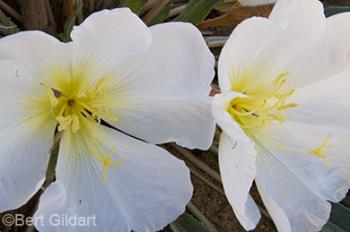Belly Plants
©Bert Gildart: “Belly plants” are defined as: “plants that must be observed while lying on your belly to enjoy.” Because we are now camped in the Mojave National Preserve, plants that grow in this dry and sometimes blustery environment tend to be “belly plants.” They’ve acquired that low-hugging feature to help prevent desiccation.
Other survival features of such species include waxy stems and the production of tiny hairs that fringe a plant’s stem.
Though not all the species posted here are “belly plants” several are. Regardless, all are now blooming in this glorious spring of 2008, essentially because, according to a park biologists, of the abundant rain. “Best season we experienced since 2005,” said the researcher we meet at the Kelso Dunes, where we are now camped. The lady was researching bees unique to the dunes area, but stopped for a moment to visit.
Here are a few of the “belly plants” now flowering in the Mojave Desert.

Dune Evening Primrose
The DUNE EVENING PRIMROSE is a month early, according to the friendly biologist. It produces a beautiful white flower and those flowers are now dotting the base of the Kelso Dunes, which is, incidentally, the third largest in the nation. The flowers are quite fragrant. “As the plant dries out,” notes our reference book, Mojave Desert Wildflowers, “the stems curl toward the center and produce a characteristic ‘bird cage.’”

Verbena
One of the most beautiful plants is VERBENA, (and I hope I’ve I.D this plant correctly). From a photographer’s point of view the tiny repetitious flowers combine to create a nice pattern as does the slight curve formed by the individual flowers. We found the plant on a desert wash, which seems to characterize the habitat in which the species grow.

Desert Star
Finally, here’s an image of what truly is a “belly plant,” the DESERT STAR. The plant grows in clumps, which is yet another survival technique. Plants in clusters can more easily retain moisture.
All photographs of these plants were taken from a tripod, but because this particular plant grows so low, I had to dig several holes in the ground to adequately lower my camera. All these photographs, incidentally, were taken with natural light. However, because I think most close up photographs look better in subdued light, I inserted myself between sun and plant, so creating a shadow. As well, all photographs were taken at very slow shutter speeds (about 1/15 of a second) so that I could use tiny apertures (f-32) to enhance depth of field.

